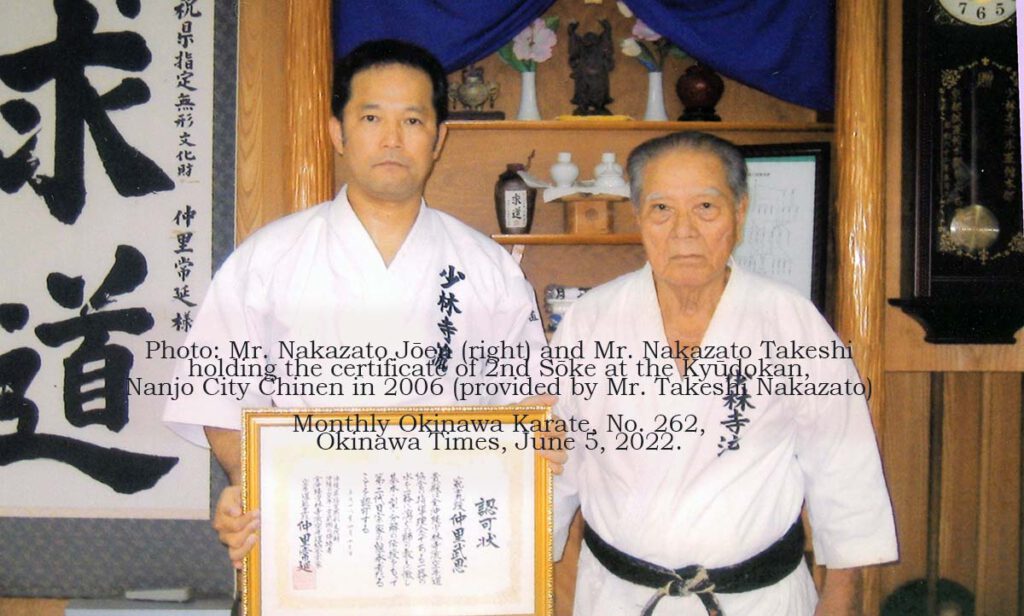- The following is from an article published in the Okinawa Times: “Inheriting the essence. Faithfully inheriting the ancestor’s kata. Nakazato Takeshi (60), 2nd generation Sōke of Shōrinji-ryū and Chairman of Zen Okinawa Shōrinji-ryū Karatedo Kyōkai. Inheriting the techniques of Chanmī’s Anankū. Maintaining the shortest “unaltered” [technique] without futility. Monthly Okinawa Karate, No. 262, Okinawa Times, June 5, 2022.
“You shouldn’t change any of the kata you learned from your predecessors. This is because it is logical to use the body to perform the techniques in the shortest time without overdoing, waste, or unevenness.” With the teachings of his teacher in mind, Nakazato Takeshi (60), the 2nd generation Sōke of Shōrinji-ryū and Chairman of Zen Okinawa Shōrinji-ryū Karatedo Kyōkai, sticks to the “principle of unaltering.” He received his education from Mr. Nakazato Jōen (1922-2010), who is the first Sōke and also the same paternal line of family and teaches his disciples the kata he learned in daily training. (Matayoshi Kenji, Southern News Department)
Mr. Nakazato Jōen, a school teacher and former village headman of Chinen, was a strict and straightforward person. Looking back, when he was in the fifth grade of Chinen Elementary School, Nakazato Takeshi entered the Nakazato Dōjō in 1973, where his four years older brother and people from the area were learning.
First of all, the beginners worked hard on the progress of foot work. It is said that if you do not move correctly, the power of the technique will not be transmitted, and after training for several months, Nakazato Takeshi learned the basic techniques such as thrusting and kicking.
The training was centered on learning the kata, and while Mr. [Nakazato] Jōen was watching, he [Takeshi] would show off [the kata moves] one by one. During the performance, he [Takeshi] speculated, “What was wrong?” but he said, “I didn’t feel like I could ask questions” during the instruction, so he got into the habit of thinking about things for himself.
Mr. Nakazato Takeshi was absorbed in the growth of his skills through training and the feeling that he was “strengthening himself” with the kumite he was doing when he was young. In 2006, after being praised for his attitude toward karate, Mr. Nakazato Jōen asked him, “Would you like to take on as the second generation?” He felt as if he was prepared and accepted, “If you are ok with me?!”
He serves as the president of a subsidiary company of Okinawa Electric Power Co., Inc. On Saturdays he tries not to work and teaches four high-ranking students once a week. After returning home, he spends 1-2 hours almost every day on the second floor of his home in Yonabaru to practice kata.
It’s not difficult to remember the sequential order of the kata. However, he emphasized, “Don’t practice the kata indiscriminately. It is necessary to practice it while considering the meaning of the thread of techniques.” In teaching, I also make every effort to understand the technique.
Mr. Nakazato Takeshi says, “My role is to pass on the inherited kata to the next generation without adding anything or subtracting anything.” “I think it’s the Sōke‘s job to aim for quality rather than quantitative expansion,” he said.
The Kyūdōkan has a framed writing saying “Ikki Suisha Ikki” – one vessel represents one vessel. It means to inherit the technique and the spirit in its entirety, like transferring water from one vessel to another. In the Shōrinji-ryū, it means to inherit the direct tradition of Mr. Kyan Chōtoku (1870–1945), a leading figure in the Okinawan karate world known as Chanmī.
The Ānankū that Mr. Kyan Chōtoku learned from a master in Taiwan is transmitted only in the Shōrinji-ryū. There are techniques such as shutō-uke, morote-uke, and continuous thrusts, and it is a kata in which you can learn the basics.
Kūsankū teaches the idea of “karate ni sente nashi” (There is no first attack in karate). You draw a circle with your hands to prevent four attacks, and then move on to offense and defense. It is taught to those who have 5th Dan or higher.
Tokumine no Kon has continuous deflections and attacks using a bō of 6-foot length, as well as a quick-moving thrusting and striking techniques. After Mr. Nakazato Takeshi received his 6th dan, he learned this kata from Mr. Nakazato Jōen.
Takeshi says, “I have an emotional attachment for all the kata. I’m still in the middle of the way, so I’d like to continue to pursue them.”
There is a framed writing in the Kyūdōkan that says, “Yesterday’s first rank (shodan) is not necessarily tomorrow’s first rank (shodan). You have to do it today.” Like this, he stresses the importance of daily practice and also preaches this to his students.
© 2022, Andreas Quast. All rights reserved.

